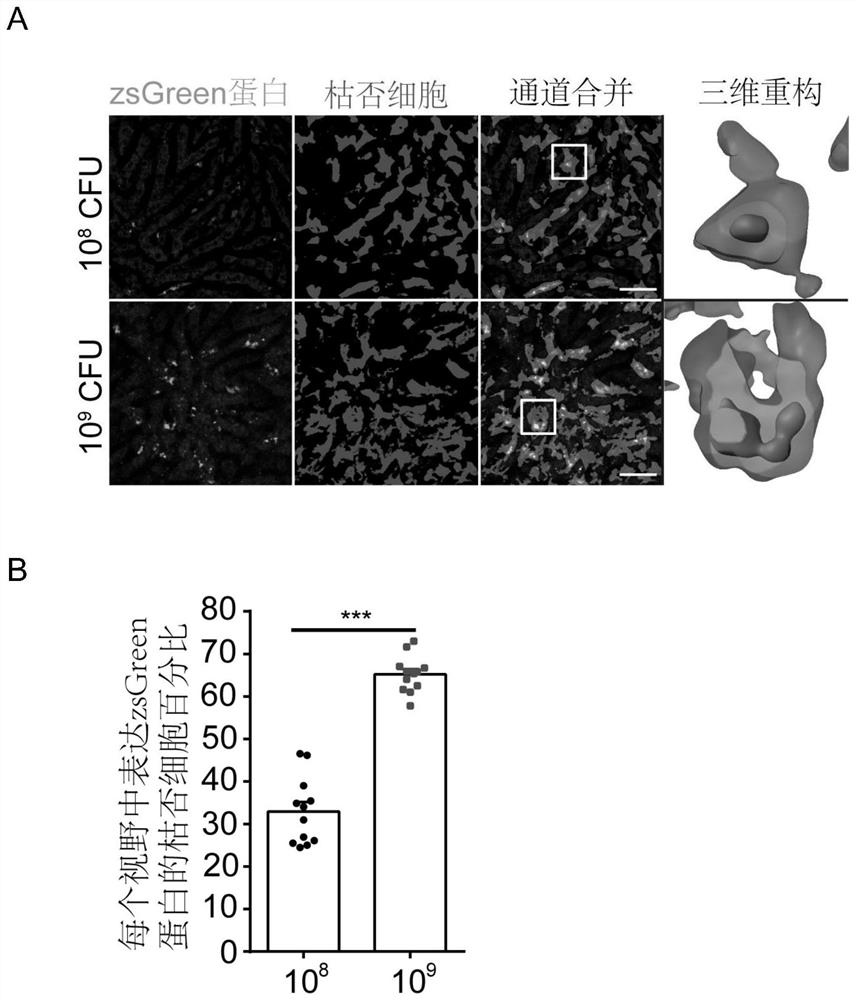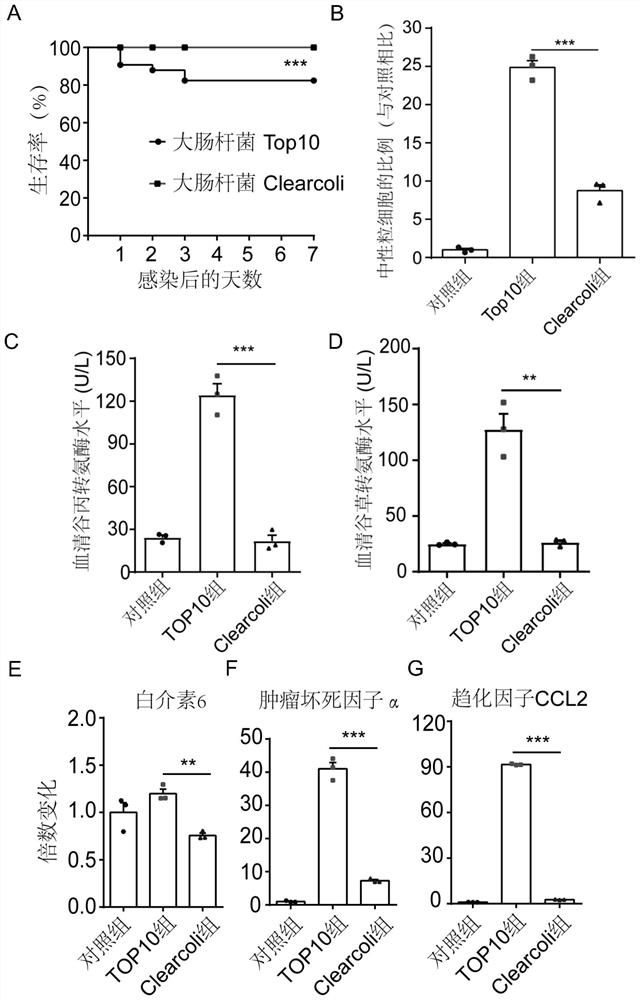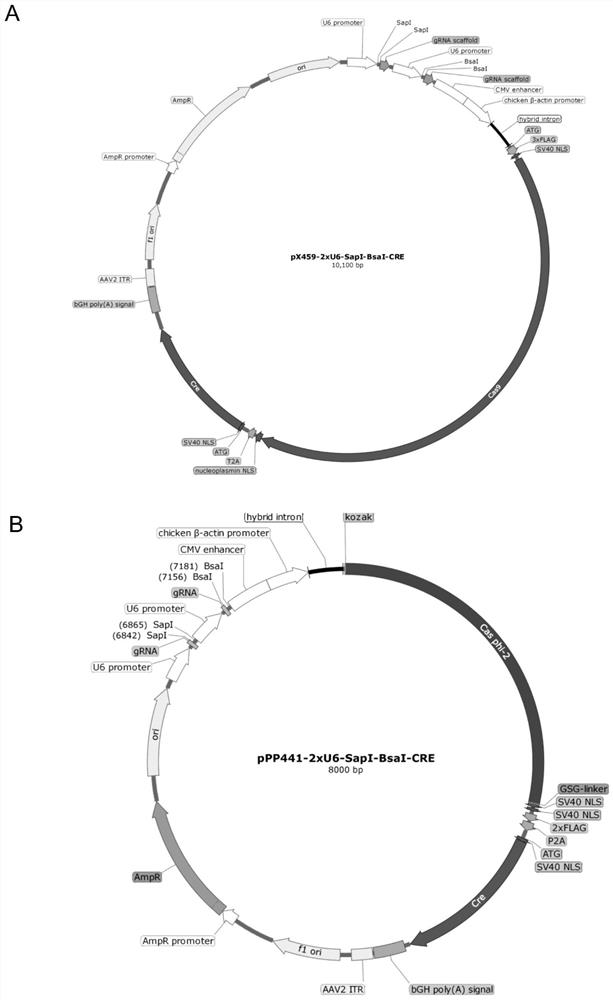Pharmaceutical composition targeting kuptake cells for treating cancer
A composition and drug technology, applied in the field of drug delivery, can solve the problems of low specificity of targeting Kupffer cells, complex mechanism of action in vivo, cumbersome operation procedures, etc., and achieve the treatment of liver metastases with low cost and strong operability Effect
- Summary
- Abstract
- Description
- Claims
- Application Information
AI Technical Summary
Problems solved by technology
Method used
Image
Examples
Embodiment 1
[0060] Example 1: Detection of the expression of bacteria-delivered DNA plasmids in living liver Kupffer cells
[0061] 1. Construction of pX459-zsGreen plasmid
[0062] Using the pX459 vector (addgene, #78623) as a blueprint, cut the vector with restriction endonuclease AgeI (NEB, #R0552S) to linearize the vector; then, use the Escherichia coli recombinase Exnase II (Vazyme, #C214) The zsGreen1 coding DNA sequence (as shown in SEQ ID NO:39) containing the start codon ATG and the stop codon TGA is recombined into the vector to obtain the pX459-zsGreen plasmid expressing by zsGreen1 instead of Cas9, so that zsGreen1 can be used as a reporter gene To explore whether the pX459 vector and its encoded protein can be expressed in Kupffer cells. The principle is: the pX459-zsGreen plasmid is driven by a eukaryotic promoter and will not be expressed in bacteria. By injecting mice with bacteria containing the plasmid, if the plasmid DNA is successfully delivered into Kupffer cells and...
Embodiment 2
[0065] Embodiment 2: Contrast the safety of using common escherichia coli (Top10) and low toxicity escherichia coli (Clearcoli)
[0066] 1. Comparing the 7-day survival rate of blood injection of low-toxic E. coli and common E. coli
[0067] In order to reduce the immune response caused by bacterial injection, we selected LPS (lipopolysaccharide, bacterial lipopolysaccharide) mutant low-toxic Escherichia coli instead of common Escherichia coli as the delivery vector of plasmid DNA. Through the tail vein of the mouse, respectively, 1×10 9 CFU of Escherichia coli Top10 or Clearcoli (Lucigen, #60810-1) (or known as BL21(DE3)) was injected into the blood of mice, and the survival of mice within seven days was observed and recorded, such as figure 2 Shown in A: the seven-day survival rate of mice injected with Top10 tail vein is about 80%, while the seven-day survival rate of mice injected with Clearcoli tail vein is increased to 100%.
[0068] 2. Comparing the expression of i...
Embodiment 3
[0074] Example 3: Construction of pX459-2U6-SapI-BsaI-CRE and pPP441-2U6-SapI-BsaI-CRE vectors
[0075] 1. pX459 (CRISPR / Ca9 system) transformation:
[0076]Using pX459 (addgene, #78623) as the blueprint, first double-enzyme the vector with restriction enzymes BsiWI (NEB, R0553S) and BsaI (NEB, R3733S) (two sites on the puromycin resistance gene) cutting, cutting out the puromycin resistance gene, and then using Escherichia coli recombinase Exnase II (Vazyme, C214) to convert the CRE enzyme (to eliminate the redundant BsaI restriction site on the vector, its sequence is shown in SEQ ID NO: 40 ) was recombined into the vector to obtain a vector in which puromycin was replaced by CRE enzyme; then, between the restriction endonuclease sites XbaI (NEB, R0145S) and KpnI (NEB, R0142S) in front of the CMV enhancer Insert T4 DNA ligase (TIANGEN, NG201) into the multiple cloning site (HindIII / XhoI / BamHI / SalI, whose sequence is shown in SEQ ID NO: 41), and then insert U6-BsaI between X...
PUM
 Login to View More
Login to View More Abstract
Description
Claims
Application Information
 Login to View More
Login to View More - R&D
- Intellectual Property
- Life Sciences
- Materials
- Tech Scout
- Unparalleled Data Quality
- Higher Quality Content
- 60% Fewer Hallucinations
Browse by: Latest US Patents, China's latest patents, Technical Efficacy Thesaurus, Application Domain, Technology Topic, Popular Technical Reports.
© 2025 PatSnap. All rights reserved.Legal|Privacy policy|Modern Slavery Act Transparency Statement|Sitemap|About US| Contact US: help@patsnap.com



